Looking for something awesome, interesting, and educational to read? Check out some of these books! You are welcome to borrow any of these titles from me at any time (or else they are available from our library), just be sure to return them when you are done.
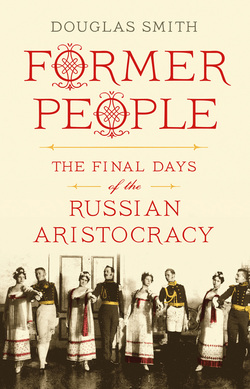
Former People: The Final Days of the Russian Aristocracy by Douglas Smith
Epic in scope, precise in detail, and heart-breaking in its human drama, Former People is the first book to recount the history of the aristocracy caught up in the maelstrom of the Bolshevik Revolution and the creation of Stalin’s Russia. Filled with chilling tales of looted palaces and burning estates, of desperate flights in the night from marauding peasants and Red Army soldiers, of imprisonment, exile, and execution, it is the story of how a centuries’-old elite, famous for its glittering wealth, its service to the Tsar and Empire, and its promotion of the arts and culture, was dispossessed and destroyed along with the rest of old Russia.
Yet Former People is also a story of survival and accommodation, of how many of the tsarist ruling class—so-called “former people” and “class enemies”—overcame the psychological wounds inflicted by the loss of their world and decades of repression as they struggled to find a place for themselves and their families in the new, hostile order of the Soviet Union. Chronicling the fate of two great aristocratic families—the Sheremetevs and the Golitsyns—it reveals how even in the darkest depths of the terror, daily life went on.
Told with sensitivity and nuance by acclaimed historian Douglas Smith, Former People is the dramatic portrait of two of Russia’s most powerful aristocratic families, and a sweeping account of their homeland in violent transition
Epic in scope, precise in detail, and heart-breaking in its human drama, Former People is the first book to recount the history of the aristocracy caught up in the maelstrom of the Bolshevik Revolution and the creation of Stalin’s Russia. Filled with chilling tales of looted palaces and burning estates, of desperate flights in the night from marauding peasants and Red Army soldiers, of imprisonment, exile, and execution, it is the story of how a centuries’-old elite, famous for its glittering wealth, its service to the Tsar and Empire, and its promotion of the arts and culture, was dispossessed and destroyed along with the rest of old Russia.
Yet Former People is also a story of survival and accommodation, of how many of the tsarist ruling class—so-called “former people” and “class enemies”—overcame the psychological wounds inflicted by the loss of their world and decades of repression as they struggled to find a place for themselves and their families in the new, hostile order of the Soviet Union. Chronicling the fate of two great aristocratic families—the Sheremetevs and the Golitsyns—it reveals how even in the darkest depths of the terror, daily life went on.
Told with sensitivity and nuance by acclaimed historian Douglas Smith, Former People is the dramatic portrait of two of Russia’s most powerful aristocratic families, and a sweeping account of their homeland in violent transition
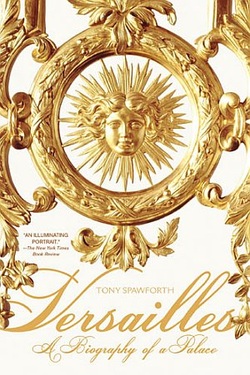
Versailles: Biography of a Palace by Tony Spawforth
Called “fast-paced” (Kirkus Reviews) and “highly engrossing” (Publishers Weekly), this is the behind-the-scenes story of the world’s most famous palace.
The story of Versailles is one of high historical drama mixed with the high camp and glamour of the European courts, all in an iconic home for the French arts. The palace itself has been radically altered since 1789. Versailles sets out to rediscover what is now a vanished world: a great center of power and, for thousands, a home both grand and squalid.
Using the latest historical research, Spawforth offers the first full account of Versailles in English in over thirty years. He probes the conventional picture of this “perpetual house party” and gives full weight to the darker side: not just the mounting discomfort of the aging palace but also the intrigue and status anxiety of its aristocrats, as well as the changing place of Versailles in France’s national identity since 1789.
Many books have told the stories of the royals and artists living in Versailles, but this is the first to turn its focus on the palace itself—from architecture to politics to scandal to restoration.
Called “fast-paced” (Kirkus Reviews) and “highly engrossing” (Publishers Weekly), this is the behind-the-scenes story of the world’s most famous palace.
The story of Versailles is one of high historical drama mixed with the high camp and glamour of the European courts, all in an iconic home for the French arts. The palace itself has been radically altered since 1789. Versailles sets out to rediscover what is now a vanished world: a great center of power and, for thousands, a home both grand and squalid.
Using the latest historical research, Spawforth offers the first full account of Versailles in English in over thirty years. He probes the conventional picture of this “perpetual house party” and gives full weight to the darker side: not just the mounting discomfort of the aging palace but also the intrigue and status anxiety of its aristocrats, as well as the changing place of Versailles in France’s national identity since 1789.
Many books have told the stories of the royals and artists living in Versailles, but this is the first to turn its focus on the palace itself—from architecture to politics to scandal to restoration.
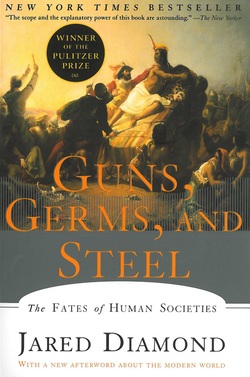
Guns, Germs, and Steel: The Fates of Human Societies by Jared Diamond
Winner of the Pulitzer Prize, Guns, Germs, and Steel is a brilliant work answering the question of why the peoples of certain continents succeeded in invading other continents and conquering or displacing their peoples. This edition includes a new chapter on Japan and all-new illustrations drawn from the television series. Until around 11,000 BC, all peoples were still Stone Age hunter/gatherers. At that point, a great divide occurred in the rates that human societies evolved. In Eurasia, parts of the Americas, and Africa, farming became the prevailing mode of existence when indigenous wild plants and animals were domesticated by prehistoric planters and herders. As Jared Diamond vividly reveals, the very people who gained a head start in producing food would collide with preliterate cultures, shaping the modern world through conquest, displacement, and genocide.The paths that lead from scattered centers of food to broad bands of settlement had a great deal to do with climate and geography. But how did differences in societies arise? Why weren't native Australians, Americans, or Africans the ones to colonize Europe? Diamond dismantles pernicious racial theories tracing societal differences to biological differences. He assembles convincing evidence linking germs to domestication of animals, germs that Eurasians then spread in epidemic proportions in their voyages of discovery. In its sweep, Guns, Germs and Steel encompasses the rise of agriculture, technology, writing, government, and religion, providing a unifying theory of human history as intriguing as the histories of dinosaurs and glaciers.
Winner of the Pulitzer Prize, Guns, Germs, and Steel is a brilliant work answering the question of why the peoples of certain continents succeeded in invading other continents and conquering or displacing their peoples. This edition includes a new chapter on Japan and all-new illustrations drawn from the television series. Until around 11,000 BC, all peoples were still Stone Age hunter/gatherers. At that point, a great divide occurred in the rates that human societies evolved. In Eurasia, parts of the Americas, and Africa, farming became the prevailing mode of existence when indigenous wild plants and animals were domesticated by prehistoric planters and herders. As Jared Diamond vividly reveals, the very people who gained a head start in producing food would collide with preliterate cultures, shaping the modern world through conquest, displacement, and genocide.The paths that lead from scattered centers of food to broad bands of settlement had a great deal to do with climate and geography. But how did differences in societies arise? Why weren't native Australians, Americans, or Africans the ones to colonize Europe? Diamond dismantles pernicious racial theories tracing societal differences to biological differences. He assembles convincing evidence linking germs to domestication of animals, germs that Eurasians then spread in epidemic proportions in their voyages of discovery. In its sweep, Guns, Germs and Steel encompasses the rise of agriculture, technology, writing, government, and religion, providing a unifying theory of human history as intriguing as the histories of dinosaurs and glaciers.
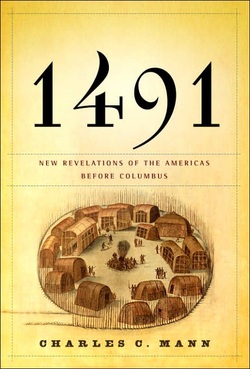
1491: New Revelations of the Americas before Columbus by Charles C. Mann
In this groundbreaking work of science, history, and archaeology, Charles C. Mann radically alters our understanding of the Americas before the arrival of Columbus in 1492.
Contrary to what so many Americans learn in school, the pre-Columbian Indians were not sparsely settled in a pristine wilderness; rather, there were huge numbers of Indians who actively molded and influenced the land around them. The astonishing Aztec capital of Tenochtitlan had running water and immaculately clean streets, and was larger than any contemporary European city. Mexican cultures created corn in a specialized breeding process that it has been called man’s first feat of genetic engineering. Indeed, Indians were not living lightly on the land but were landscaping and manipulating their world in ways that we are only now beginning to understand. Challenging and surprising, this a transformative new look at a rich and fascinating world we only thought we knew
In this groundbreaking work of science, history, and archaeology, Charles C. Mann radically alters our understanding of the Americas before the arrival of Columbus in 1492.
Contrary to what so many Americans learn in school, the pre-Columbian Indians were not sparsely settled in a pristine wilderness; rather, there were huge numbers of Indians who actively molded and influenced the land around them. The astonishing Aztec capital of Tenochtitlan had running water and immaculately clean streets, and was larger than any contemporary European city. Mexican cultures created corn in a specialized breeding process that it has been called man’s first feat of genetic engineering. Indeed, Indians were not living lightly on the land but were landscaping and manipulating their world in ways that we are only now beginning to understand. Challenging and surprising, this a transformative new look at a rich and fascinating world we only thought we knew

The Devil in the White City: Murder, Magic, and Madness at the Fair that Changed America by Erik Larson
Author Erik Larson imbues the incredible events surrounding the 1893 Chicago World's Fair with such drama that readers may find themselves checking the book's categorization to be sure that The Devil in the White City is not, in fact, a highly imaginative novel. Larson tells the stories of two men: Daniel H. Burnham, the architect responsible for the fair's construction, and H.H. Holmes, a serial killer masquerading as a charming doctor. Burnham's challenge was immense. In a short period of time, he was forced to overcome the death of his partner and numerous other obstacles to construct the famous "White City" around which the fair was built. His efforts to complete the project, and the fair's incredible success, are skillfully related along with entertaining appearances by such notables as Buffalo Bill Cody, Susan B. Anthony, and Thomas Edison. The activities of the sinister Dr. Holmes, who is believed to be responsible for scores of murders around the time of the fair, are equally remarkable. He devised and erected the World's Fair Hotel, complete with crematorium and gas chamber, near the fairgrounds and used the event as well as his own charismatic personality to lure victims. Combining the stories of an architect and a killer in one book, mostly in alternating chapters, seems like an odd choice but it works. The magical appeal and horrifying dark side of 19th-century Chicago are both revealed through Larson's skillful writing.
Author Erik Larson imbues the incredible events surrounding the 1893 Chicago World's Fair with such drama that readers may find themselves checking the book's categorization to be sure that The Devil in the White City is not, in fact, a highly imaginative novel. Larson tells the stories of two men: Daniel H. Burnham, the architect responsible for the fair's construction, and H.H. Holmes, a serial killer masquerading as a charming doctor. Burnham's challenge was immense. In a short period of time, he was forced to overcome the death of his partner and numerous other obstacles to construct the famous "White City" around which the fair was built. His efforts to complete the project, and the fair's incredible success, are skillfully related along with entertaining appearances by such notables as Buffalo Bill Cody, Susan B. Anthony, and Thomas Edison. The activities of the sinister Dr. Holmes, who is believed to be responsible for scores of murders around the time of the fair, are equally remarkable. He devised and erected the World's Fair Hotel, complete with crematorium and gas chamber, near the fairgrounds and used the event as well as his own charismatic personality to lure victims. Combining the stories of an architect and a killer in one book, mostly in alternating chapters, seems like an odd choice but it works. The magical appeal and horrifying dark side of 19th-century Chicago are both revealed through Larson's skillful writing.

The Mapmaker's Wife: A True Tale of Love, Murder, and Survival in the Amazon by Robert Whitaker
The year is 1735. A decade-long expedition to South America is launched by a team of French scientists racing to measure the circumference of the earth and to reveal the mysteries of a little-known continent to a world hungry for discovery and knowledge. From this extraordinary journey arose an unlikely love between one scientist and a beautiful Peruvian noblewoman. Victims of a tangled web of international politics, Jean Godin and Isabel Gramesón’s destiny would ultimately unfold in the Amazon’s unforgiving jungles, and it would be Isabel’s quest to reunite with Jean after a calamitous twenty-year separation that would capture the imagination of all of eighteenth-century Europe. A remarkable testament to human endurance, female resourcefulness, and enduring love, Isabel Gramesón’s survival remains unprecedented in the annals of Amazon exploration.
The year is 1735. A decade-long expedition to South America is launched by a team of French scientists racing to measure the circumference of the earth and to reveal the mysteries of a little-known continent to a world hungry for discovery and knowledge. From this extraordinary journey arose an unlikely love between one scientist and a beautiful Peruvian noblewoman. Victims of a tangled web of international politics, Jean Godin and Isabel Gramesón’s destiny would ultimately unfold in the Amazon’s unforgiving jungles, and it would be Isabel’s quest to reunite with Jean after a calamitous twenty-year separation that would capture the imagination of all of eighteenth-century Europe. A remarkable testament to human endurance, female resourcefulness, and enduring love, Isabel Gramesón’s survival remains unprecedented in the annals of Amazon exploration.

Marie Antoinette: The Journey by Antonia Fraser
France’s beleaguered queen, Marie Antoinette, wrongly accused of uttering the infamous “Let them eat cake,” was the subject of ridicule and curiosity even before her death; she has since been the object of debate and speculation and the fascination so often accorded tragic figures in history. Married in mere girlhood, this essentially lighthearted, privileged, but otherwise unremarkable child was thrust into an unparalleled time and place, and was commanded by circumstance to play a significant role in history. Antonia Fraser’s lavish and engaging portrait of Marie Antoinette, one of the most recognizable women in European history, excites compassion and regard for all aspects of her subject, immersing the reader not only in the coming-of-age of a graceful woman, but also in the unraveling of an era
France’s beleaguered queen, Marie Antoinette, wrongly accused of uttering the infamous “Let them eat cake,” was the subject of ridicule and curiosity even before her death; she has since been the object of debate and speculation and the fascination so often accorded tragic figures in history. Married in mere girlhood, this essentially lighthearted, privileged, but otherwise unremarkable child was thrust into an unparalleled time and place, and was commanded by circumstance to play a significant role in history. Antonia Fraser’s lavish and engaging portrait of Marie Antoinette, one of the most recognizable women in European history, excites compassion and regard for all aspects of her subject, immersing the reader not only in the coming-of-age of a graceful woman, but also in the unraveling of an era
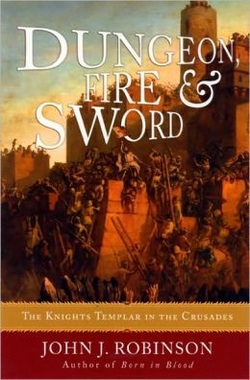
Dungeon, Fire, and Sword: The Knights Templar in the Crusades by John J. Robinson
Over the past thousand years, the bloodiest game of the king-of-the-hill has been for supremacy on the Temple Mount in Jerusalem, the site of the ancient Temple of Solomon. This book recounts the stirring saga of the Knights Templar, the Christian warrior-monks who occupied the sacred Mount in the aftermath of the butchery of the First Crusade. Recruited to a life of poverty, chastity and obedience intended to lead only to martyrdom on the battlefield, they were totally dedicated to the pious paradox that the wholesale slaughter of non-believers would earn the eternal gratitude of the Prince of Peace.
In telling the incredible story of the Knights Templar, the author's clear explanation of the cultural and religious differences among the Templars' enemies and friends in the Middle East gives fresh understanding of the people who populate this restless region. Here are the Sunnies and the Shiites, the Kurds and Armenians, the Arabs and Turks, who figure so prominently in today's headlines. The similarity of their antagonisms today and those of eight hundred years ago are often so striking as to be eerie. Dungeon, Fire & Sword is a brilliant work of narrative history that can be read as an adventure story, a morality play, or a lesson in the politics of warfare.
Over the past thousand years, the bloodiest game of the king-of-the-hill has been for supremacy on the Temple Mount in Jerusalem, the site of the ancient Temple of Solomon. This book recounts the stirring saga of the Knights Templar, the Christian warrior-monks who occupied the sacred Mount in the aftermath of the butchery of the First Crusade. Recruited to a life of poverty, chastity and obedience intended to lead only to martyrdom on the battlefield, they were totally dedicated to the pious paradox that the wholesale slaughter of non-believers would earn the eternal gratitude of the Prince of Peace.
In telling the incredible story of the Knights Templar, the author's clear explanation of the cultural and religious differences among the Templars' enemies and friends in the Middle East gives fresh understanding of the people who populate this restless region. Here are the Sunnies and the Shiites, the Kurds and Armenians, the Arabs and Turks, who figure so prominently in today's headlines. The similarity of their antagonisms today and those of eight hundred years ago are often so striking as to be eerie. Dungeon, Fire & Sword is a brilliant work of narrative history that can be read as an adventure story, a morality play, or a lesson in the politics of warfare.

Undaunted Courage: Meriwether Lewis, Thomas Jefferson, and the Opening of the American West by Stephen E. Ambrose
In this sweeping adventure story, Stephen E. Ambrose, the bestselling author of D-Day, presents the definitive account of one of the most momentous journeys in American history. Ambrose follows the Lewis and Clark Expedition from Thomas Jefferson's hope of finding a waterway to the Pacific, through the heart-stopping moments of the actual trip, to Lewis's lonely demise on the Natchez Trace. Along the way, Ambrose shows us the American West as Lewis saw it -- wild, awesome, and pristinely beautiful.Undaunted Courage is a stunningly told action tale that will delight readers for generations.
In this sweeping adventure story, Stephen E. Ambrose, the bestselling author of D-Day, presents the definitive account of one of the most momentous journeys in American history. Ambrose follows the Lewis and Clark Expedition from Thomas Jefferson's hope of finding a waterway to the Pacific, through the heart-stopping moments of the actual trip, to Lewis's lonely demise on the Natchez Trace. Along the way, Ambrose shows us the American West as Lewis saw it -- wild, awesome, and pristinely beautiful.Undaunted Courage is a stunningly told action tale that will delight readers for generations.
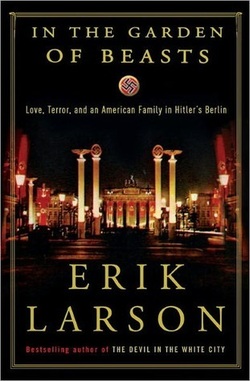
In the Garden of Beasts: Love, Terror, and an American Family in Hitler's Berlin by Erik Larson
The time is 1933, the place, Berlin, when William E. Dodd becomes America’s first ambassador to Hitler’s Nazi Germany in a year that proved to be a turning point in history.
A mild-mannered professor from Chicago, Dodd brings along his wife, son, and flamboyant daughter, Martha. At first Martha is entranced by the parties and pomp, and the handsome young men of the Third Reich with their infectious enthusiasm for restoring Germany to a position of world prominence. Enamored of the “New Germany,” she has one affair after another, including with the suprisingly honorable first chief of the Gestapo, Rudolf Diels. But as evidence of Jewish persecution mounts, confirmed by chilling first-person testimony, her father telegraphs his concerns to a largely indifferent State Department back home. Dodd watches with alarm as Jews are attacked, the press is censored, and drafts of frightening new laws begin to circulate. As that first year unfolds and the shadows deepen, the Dodds experience days full of excitement, intrigue, romance—and ultimately, horror, when a climactic spasm of violence and murder reveals Hitler’s true character and ruthless ambition.
Suffused with the tense atmosphere of the period, and with unforgettable portraits of the bizarre Göring and the expectedly charming--yet wholly sinister--Goebbels, In the Garden of Beasts lends a stunning, eyewitness perspective on events as they unfold in real time, revealing an era of surprising nuance and complexity. The result is a dazzling, addictively readable work that speaks volumes about why the world did not recognize the grave threat posed by Hitler until Berlin, and Europe, were awash in blood and terror
The time is 1933, the place, Berlin, when William E. Dodd becomes America’s first ambassador to Hitler’s Nazi Germany in a year that proved to be a turning point in history.
A mild-mannered professor from Chicago, Dodd brings along his wife, son, and flamboyant daughter, Martha. At first Martha is entranced by the parties and pomp, and the handsome young men of the Third Reich with their infectious enthusiasm for restoring Germany to a position of world prominence. Enamored of the “New Germany,” she has one affair after another, including with the suprisingly honorable first chief of the Gestapo, Rudolf Diels. But as evidence of Jewish persecution mounts, confirmed by chilling first-person testimony, her father telegraphs his concerns to a largely indifferent State Department back home. Dodd watches with alarm as Jews are attacked, the press is censored, and drafts of frightening new laws begin to circulate. As that first year unfolds and the shadows deepen, the Dodds experience days full of excitement, intrigue, romance—and ultimately, horror, when a climactic spasm of violence and murder reveals Hitler’s true character and ruthless ambition.
Suffused with the tense atmosphere of the period, and with unforgettable portraits of the bizarre Göring and the expectedly charming--yet wholly sinister--Goebbels, In the Garden of Beasts lends a stunning, eyewitness perspective on events as they unfold in real time, revealing an era of surprising nuance and complexity. The result is a dazzling, addictively readable work that speaks volumes about why the world did not recognize the grave threat posed by Hitler until Berlin, and Europe, were awash in blood and terror

Naked Economics: Undressing the Dismal Science by Charles Wheelan
Finally! A book about economics that won’t put you to sleep. In fact, you won’t be able to put this bestseller down. In our challenging economic climate, this perennial favorite of students and general readers is more than a good read, it’s a necessary investment—with a blessedly sure rate of return. Demystifying buzzwords, laying bare the truths behind oft-quoted numbers, and answering the questions you were always too embarrassed to ask, the breezy Naked Economics gives readers the tools they need to engage with pleasure and confidence in the deeply relevant, not so dismal science.
This revised and updated edition adds commentary on hot topics, including the current economic crisis, globalization, the economics of information, the intersection of economics and politics, and the history—and future—of the Federal Reserve
Finally! A book about economics that won’t put you to sleep. In fact, you won’t be able to put this bestseller down. In our challenging economic climate, this perennial favorite of students and general readers is more than a good read, it’s a necessary investment—with a blessedly sure rate of return. Demystifying buzzwords, laying bare the truths behind oft-quoted numbers, and answering the questions you were always too embarrassed to ask, the breezy Naked Economics gives readers the tools they need to engage with pleasure and confidence in the deeply relevant, not so dismal science.
This revised and updated edition adds commentary on hot topics, including the current economic crisis, globalization, the economics of information, the intersection of economics and politics, and the history—and future—of the Federal Reserve
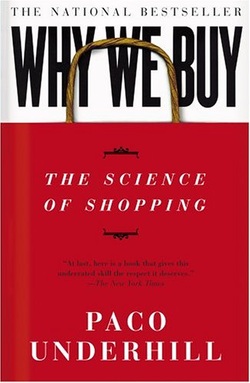
Why We Buy: the Science of Shopping by Paco Underhill
Revolutionary retail guru Paco Underhill is back with a completely revised edition of his classic, witty bestselling book on our ever-evolving consumer culture -- full of fresh observations and important lessons from the cutting edge of retail, which is taking place in the world's emerging markets. New material includes:
• The latest trends in online retail -- what retailers are doing right and what they're doing wrong -- and how nearly every Internet retailer from iTunes to Amazon can drastically improve how it serves its customers.
• A guided tour of the most innovative stores, malls and retail environments around the world -- almost all of which are springing up in countries where prosperity is new. An enormous indoor ski slope attracts shoppers to a mall in Dubai; an uber luxurious Sao Paolo department store provides its customers with personal shoppers; a mall in South Africa has a wave pool for surfing.
Revolutionary retail guru Paco Underhill is back with a completely revised edition of his classic, witty bestselling book on our ever-evolving consumer culture -- full of fresh observations and important lessons from the cutting edge of retail, which is taking place in the world's emerging markets. New material includes:
• The latest trends in online retail -- what retailers are doing right and what they're doing wrong -- and how nearly every Internet retailer from iTunes to Amazon can drastically improve how it serves its customers.
• A guided tour of the most innovative stores, malls and retail environments around the world -- almost all of which are springing up in countries where prosperity is new. An enormous indoor ski slope attracts shoppers to a mall in Dubai; an uber luxurious Sao Paolo department store provides its customers with personal shoppers; a mall in South Africa has a wave pool for surfing.